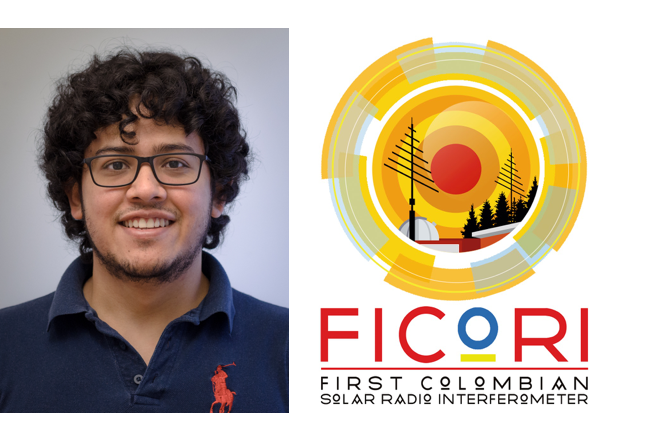
During his undergraduate education, Juan has worked in many solar related and interferometric based projects: in Colombia he built a solar radio interferometer with two antennas (the FIrst Colombian solar Radio Interferometer, FiCoRI). Once at the Space Sciences Laboratory of University of California Berkeley, Juan helped designing a ground station for a satellite mission (Cubesat Radio Interferometry Experiment, CURIE). He has also taken part to "the first-of-its-kind" citizen science project Eclipse Megamovie 2017, in the processing of thousand of photos taken by thousands of citizens during the solar eclipse in 2017.
– I would say that every single project that I have been involved before has lots of similarities with my current one.
Pointing antennas to the Sun
Since mid-September Juan has joined the RoCS in the SolarALMA project. The Atacama Large Millimeter/submillimeter Array (ALMA) telescope observes the Sun at radiowaves that let scientists explore different layers of the solar chromosphere.
– I am working with ALMA data to study the solar activity and dynamics trying to reveal a bit more of the physical processes responsible for the heating of the outermost layer of the solar atmosphere: the corona.
In love with Oslo
So far Juan has found Oslo amazing in many ways:
– I like the public transport, I like the streets, I think people is kind, I like the snow, I like to go hiking, I love the museums.
– Why the Rosseland Centre for Solar Physics (RoCS)?
– I had heard about the reputation of the solar group of the University of Oslo, but I never thought to come because here the solar physics group's approach is theoretical, while my stronger skills are observational.
However, when a position in observing the Sun with ALMA interferometer opened up, Juan decided this would be his place.
– What's your experience at ITA so far?
– I was a little afraid at the beginning, and also nervous, but fortunately I found the ITA super friendly, I feel here as in a big family, every single person is special and amazing, I have no doubts that I couldn’t find a better place than this one in terms of emotional experience.
– Any expectations?
– By the end of my PhD I expect to make a considerable contribution to the understanding of the coronal heating problem. Although this will only be a small step, knowing that I took part to the final understanding would make me extremely happy.
During his undergraduate education, Juan has worked in many solar related and interferometric based projects: in Colombia he built a solar radio interferometer with two antennas (the FIrst Colombian solar Radio Interferometer, FiCoRI). Once at the Space Sciences Laboratory of University of California Berkeley, Juan helped designing a ground station for a satellite mission (Cubesat Radio Interferometry Experiment, CURIE). He has also taken part to "the first-of-its-kind" citizen science project Eclipse Megamovie 2017, in the processing of thousand of photos taken by thousands of citizens during the solar eclipse in 2017.– I would say that every single project that I have been involved before has lots of similarities with my current one.
Pointing antennas to the Sun
Since mid-September Juan has joined the RoCS in the SolarALMA project. The Atacama Large Millimeter/submillimeter Array (ALMA) telescope observes the Sun at radiowaves that let scientists explore different layers of the solar chromosphere.
– I am working with ALMA data to study the solar activity and dynamics trying to reveal a bit more of the physical processes responsible for the heating of the outermost layer of the solar atmosphere: the corona.
In love with Oslo
So far Juan has found Oslo amazing in many ways:
– I like the public transport, I like the streets, I think people is kind, I like the snow, I like to go hiking, I love the museums.
– Why the Rosseland Centre for Solar Physics (RoCS)?
– I had heard about the reputation of the solar group of the University of Oslo, but I never thought to come because here the solar physics group's approach is theoretical, while my stronger skills are observational.
However, when a position in observing the Sun with ALMA interferometer opened up, Juan decided this would be his place.
– What's your experience at ITA so far?
– I was a little afraid at the beginning, and also nervous, but fortunately I found the ITA super friendly, I feel here as in a big family, every single person is special and amazing, I have no doubts that I couldn’t find a better place than this one in terms of emotional experience.
– Any expectations?
– By the end of my PhD I expect to make a considerable contribution to the understanding of the coronal heating problem. Although this will only be a small step, knowing that I took part to the final understanding would make me extremely happy.
